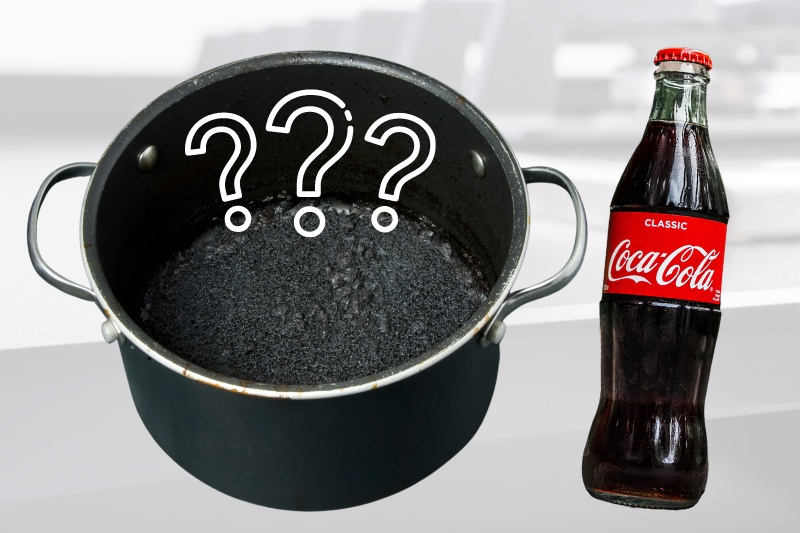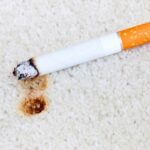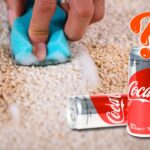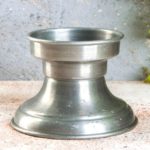Have you ever left a pan on the stove and gone to answer the front door?
A quick chat ends up being a major catch up. And several minutes later you return to a rancid smell, and a burnt pan on the hob.
The stench of a smouldering pan is yucky enough. Then you’ve got the mighty task of cleaning the worse for wear item, that’s obviously seen far better days!
Not to mention the fact that your dinner is ruined. It’s not exactly a great way to end the day.
But lucky for you, a really quick solution to your problem is to boil some Coke in the pan!
Yep, good ol’ Coca-Cola, the beverage of choice on a warm day, can actually clean burnt pans. Find out how this works below.
The acidic nature of Coke is just tough enough to break down burn marks in pans, without being so strong that it’ll ruin non-stick coatings!
How to Clean a Burnt Pan with Coke
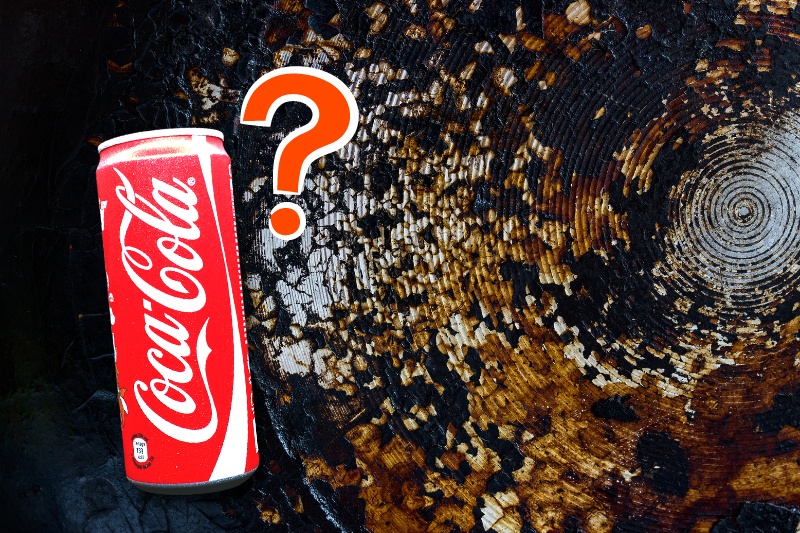
Follow the steps below to get rid of those pesky patches in your pan.
What you need:
- Kettle
- Boiling water
- Coke
- Hob
- Plastic scraper
- Steel wool pad/plastic mesh scourer
- Washing up liquid
- Cloth/sponge
Steps to follow:
- Remove waste food from the pan and pop it into an appropriate bin.
- Boil the kettle.
- Pour the boiling water from the kettle and into the pan. This will soften and dislodge some burn marks.
- Remove the boiling water from the pan.
- Pop the pan back on the hob.
- Fill the pan up with plenty of Coke (an entire can). Make sure all the burnt areas are covered.
- Start to boil the Coke in the pan.
- When the Coke starts bubbling you can turn the hob off.
- Leave the pan and its contents to cool down on the hob. You can leave the Coke in the pan for a few hours or overnight, if you’d prefer.
- When the Coke is cold and you’re ready to clean the pan, pour the liquid away.
- Start to scrape the scorch marks off the pan with a plastic scraper.
- Continue to scrape the burnt patches away.
- Grab a steel wool pad/plastic mesh scourer that’s been soaked in some warm water and washing up liquid, and gently start massaging the burnt patches.
- Rinse the debris away.
- Clean the pan again with some clean soapy water to remove any lasting grime.
- Examine the pan for marks.
- Repeat the steps above if need be.
- Dry the pan.
Note: Adjust the measurements listed above to suit the size of your pan.
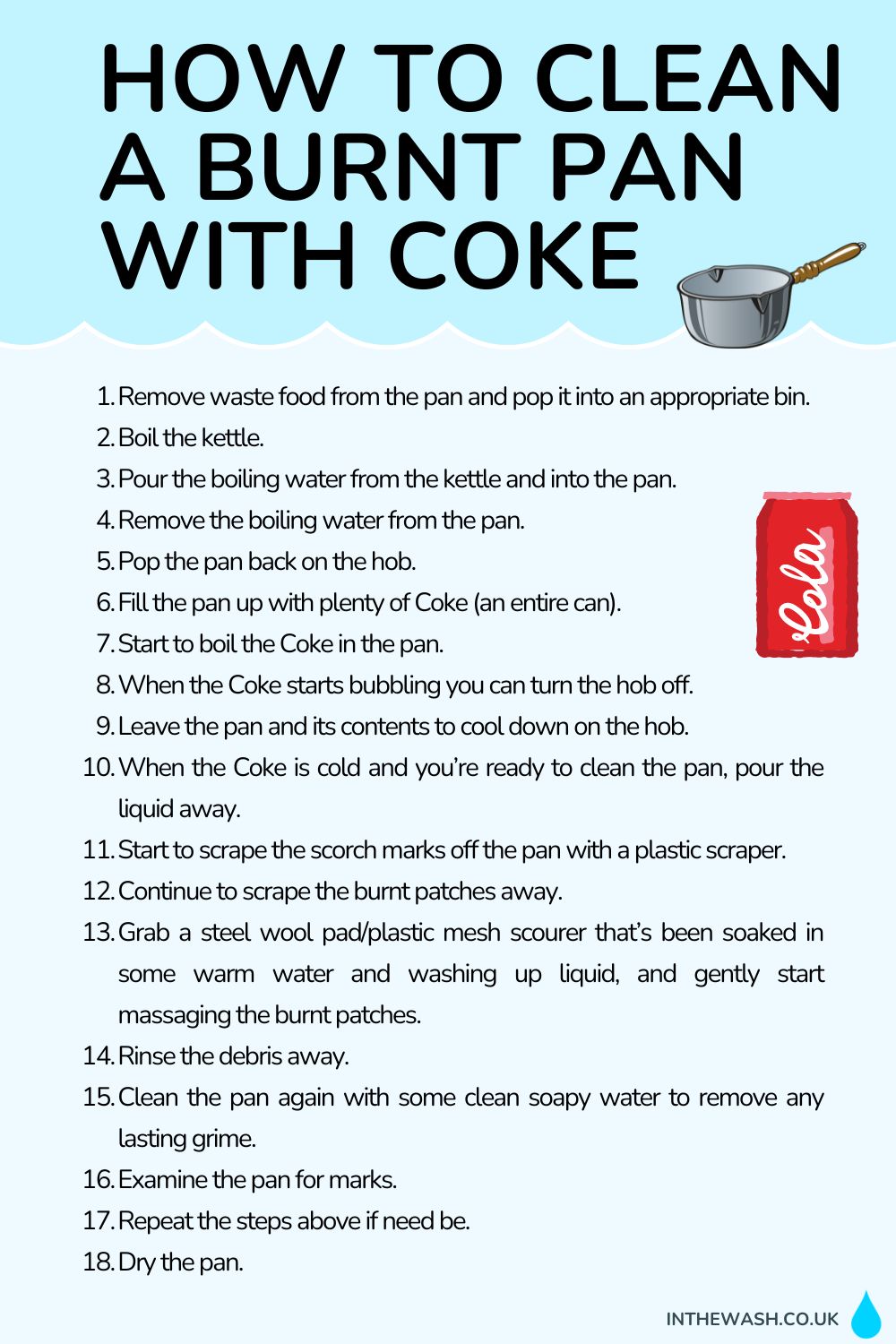
Can Coca-Cola Clean Burnt Baking Trays?
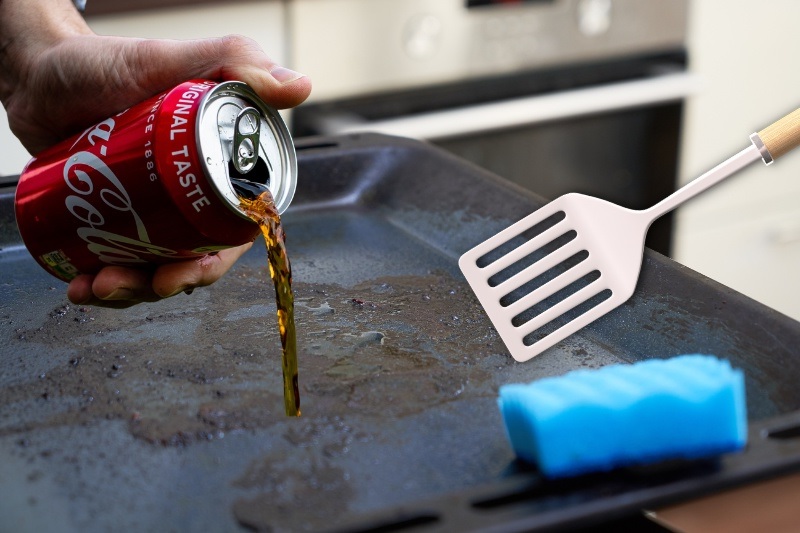
Yes, it’s possible to clean burnt trays with Coca-Cola as well. You can treat burnt trays in the same way as you’d treat a burnt pan.
Method:
- Pour diet Coke into the burnt tray.
- Leave the tray overnight.
- In the morning, pour the liquid away.
- Clean away the burnt patches with a plastic spatula.
- Remove the rest of the dirt with a sponge/scourer and some soapy warm water.
What Else Can You Clean a Burnt Pan with?
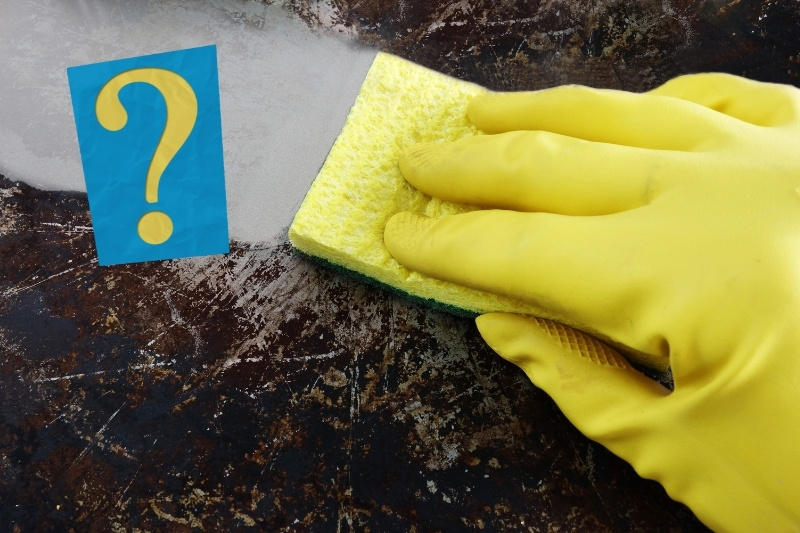
If you’re interested in finding out what else can remove burnt patches in pans, keep on reading!
Hot water and soap
- Remove any leftover food from the pan.
- Fill the pan up with water.
- Bring the pan of water to the boil.
- Use a spatula to scrape off the burnt sections in the pan.
- And then use a soapy sponge/scourer to rub off the leftover debris.
- When you’re done, empty the dirty water away and clean the pan with fresh, soapy water.
Salt
- Remove leftover food from the pan.
- Allow the pan to cool down.
- Sprinkle a generous amount of salt onto the bottom of the pan.
- Use a damp sponge to rub the salt into the pan’s surface.
- Rinse the pan.
- Repeat the steps above.
- To treat the burnt sides on your pan, chop some potatoes in half and cover them in salt.
- Rub the salted potatoes over the pan’s sides to remove the remaining scorched parts.
- Wash the pan with hot water and washing up liquid when you’re done.
Bicarbonate of soda and vinegar

- Empty any leftover food from the pan and into the bin.
- Add one part vinegar to your pan.
- Add one part water to your pan.
- Bring the liquid to the boil on the hob.
- When the liquid is boiling, remove the pan from the hob.
- Add two tablespoons of bicarbonate of soda to the pan.
- The mixture should fizzle.
- Wait a few minutes.
- Empty the pan and sponge/scour away the burnt parts.
- Repeat the steps above, if need be.
- For tougher spots, mix a little water with some bicarbonate of soda to create a paste. Then spread this paste over the scorched parts.
- Rinse the pan.
- Wash the pan with hot water and washing up liquid when you’re done.
Note: Adjust the measurements listed above to suit the size of your pan.
Lemons (not on cast iron or copper pans)
- Remove leftover food from the pan.
- Cut two to three lemons into quarters.
- Pop the cut lemons into the scorched pan.
- Fill the pan up with water.
- Bring the pan to the boil.
- Reduce the heat and allow the water to simmer on the hob for 15 minutes.
- Don’t worry if you see burnt bits floating in the water, this is supposed to happen.
- Remove the lemons from the water.
- Throw the water away.
- Wipe the pan clean with a sponge/scourer.
- Repeat the steps above, if need be.
- Wash the pan out with hot water and washing up liquid when you’re finished.
Note: Adjust the measurements listed above to suit the size of your pan.
Dishwasher tablets

- Bin any leftover food that’s in the pan.
- Fill the pan with about an inch of hot water.
- Leave the water to cool down slightly, so it’s cold enough for you to put your hand into it.
- Grab a dishwasher tablet.
- Start rubbing the pan in a circular motion with the dishwasher tablet to remove the scorched patches.
- If the dishwasher tablet dissolves, grab a new one and continue cleaning the burnt patches.
- Repeat the steps above until the burnt spots are gone.
- Clean your pan with warm water and washing up liquid when you’re done.
Foil
- Remove leftover food from the pan.
- Grab some aluminium foil.
- Scrunch the foil up in your hand.
- Pop some boiling water into the pan.
- Let the mixture rest like this for a few minutes. This will soften the scorched patches.
- Throw the water away.
- Spread two heaped tablespoons of bicarbonate of soda around the inside of the damp pan.
- Add a few teaspoons of hot water to the bicarbonate of soda, so you can make a bicarbonate of soda paste.
- Start to clean the burnt patches away by rubbing the foil and paste over the entire surface.
- Repeat the steps above until all the scorched patches have gone.
- Clean your pan with warm water and washing up liquid when you’re finished.
Why Does My Pan Get Burnt?
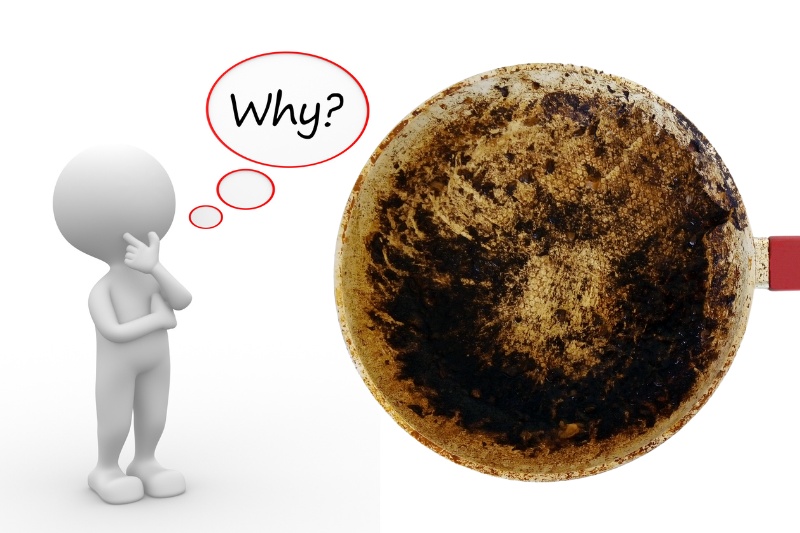
There are a number of reasons why your pan could be burning. It could be the pan itself or it could be down to the chef. Check out some more causes below:
-
- Pan is made from a low-quality material. Cheaper pans don’t always cook food evenly, so you end up with scorched patches here and there.
- No non-stick coating on the pan. If a pan has lost its non-stick coating or never had one in the first place, the food inside the pan will stick to the sides with ease.
- You’ve not added sufficient cooking oil to the pan.
- The pan is constantly left unattended, and the juices in the food dry up and start to burn instead.
How to Stop a Pan from Getting Burnt
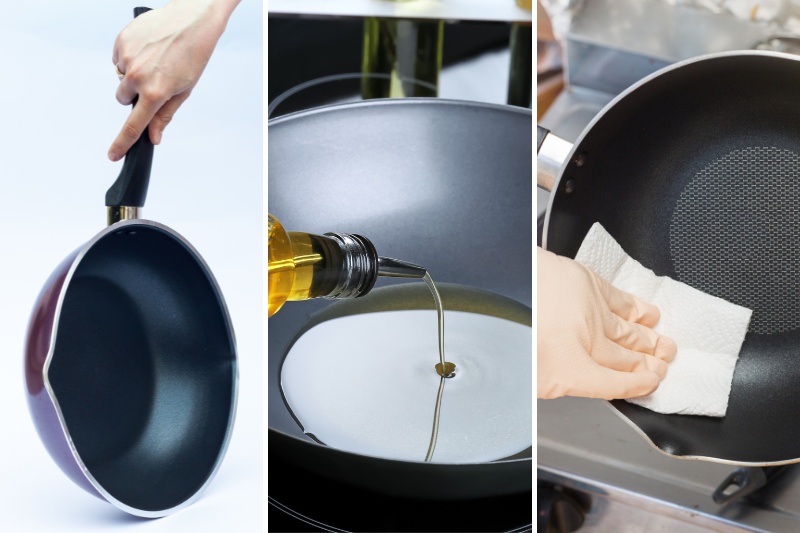
If you notice that your pan keeps getting burnt, try the tips below to stop/limit it from happening:
- Invest in a new non-stick pan. Your food shouldn’t stick to the bottom or sides of the pan, so it shouldn’t burn as easily. (You still need to watch the pan as you cook your food though!)
- Buy a pan that’s made from a quality material. Stainless steel, aluminium, cast iron and carbon steel are particularly durable materials.
- Add plenty of oil to the pan when cooking, and make sure you season cast iron pans before using them!
- Keep an eye on your pan when cooking.
- Don’t walk away from the pan! And if you have to leave it, switch the hob off.
- Replace older pans that may have lost their non-stick coatings.
- Stir the contents of your pan regularly.
- Use a suitable sized hob for the pan you’re using. If you’ve only got a small pan, use a small hob. Don’t waste energy by using a large hob because this can make your food cook too quickly, and in turn, this can burn it and the pan.
- Rotate your pan on the hob, so it heats up evenly.
- Make sure you clean your pan properly before you use it again.

Bethan has a passion for exploring, reading, cooking and gardening! When she’s not creating culinary delights for her family, she’s concocting potions to keep her house clean!
